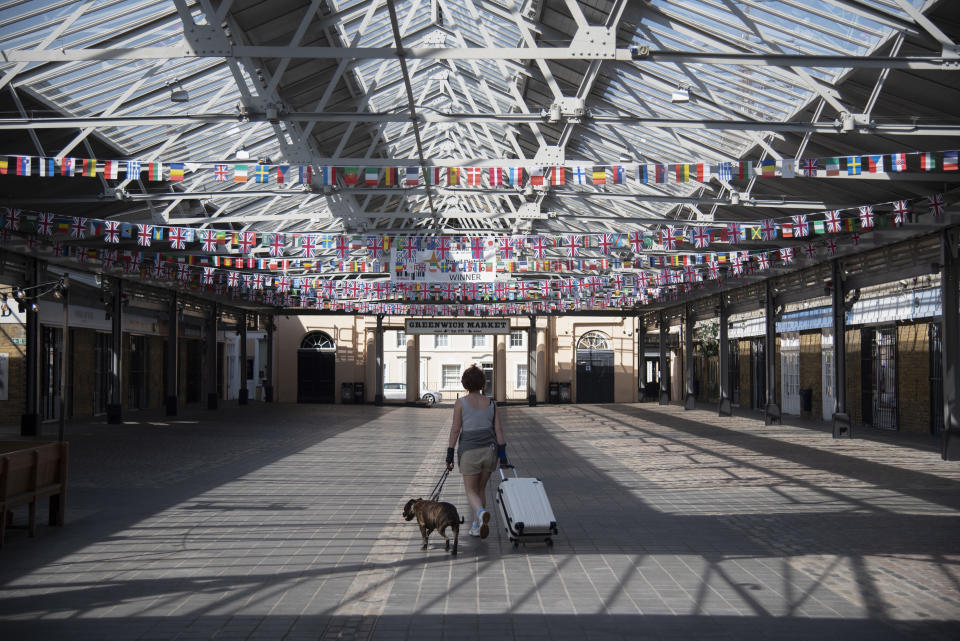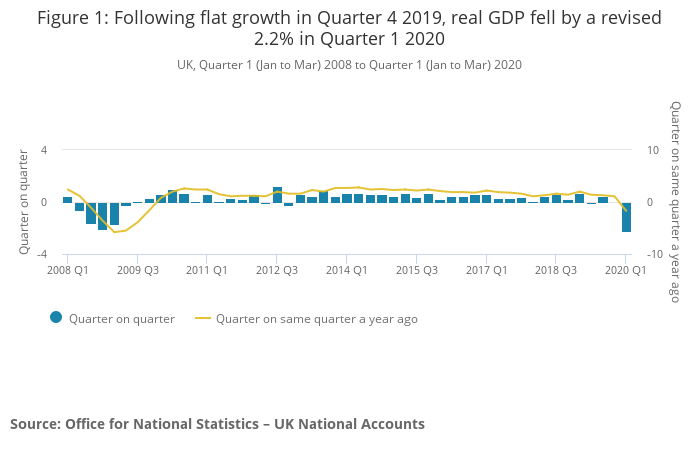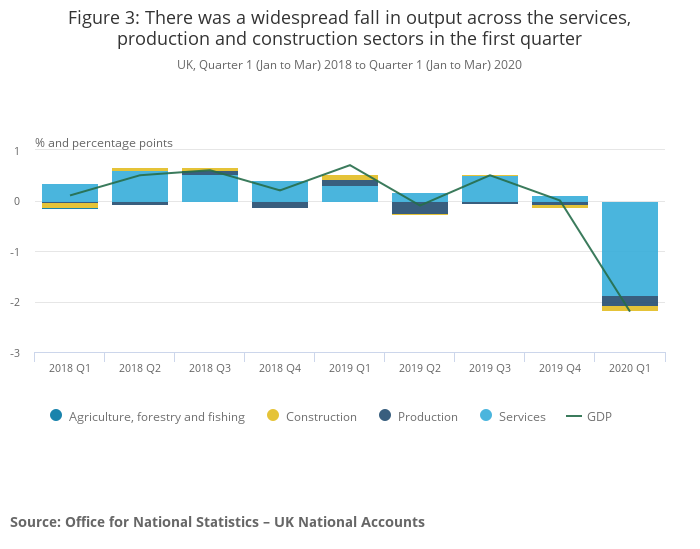Coronavirus: UK economy suffered biggest fall since 1979 as pandemic struck

The UK’s official stats watchdog has confirmed the worst slump for the UK economy in 40 years — before the full effects of the COVID-19 pandemic had even hit.
The Office for National Statistics (ONS) said on Tuesday that UK GDP contracted by 2.2% between January and the end of March 2020. It marks the biggest quarter-on-quarter fall in GDP in 40 years.
“This is the joint-third largest quarterly contraction in GDP and reflects the imposing of public health restrictions and voluntary social distancing put in place in response to the coronavirus (COVID-19) pandemic,” the ONS said.
The final tally was worse than an earlier estimate, published in May, that said GDP contracted by 2%. The 2% fall already marked the sharpest quarterly contraction since the 2008 financial crisis.
“The downward revision to quarter-on-quarter GDP growth means that Q1 saw the biggest contraction since Q3 1979, even though the lockdown only began nine days before the end of the month,” Samuel Tombs, the chief UK economist at Pantheon Macroeconomics, wrote in a note to clients.

The ONS said the services sector — everything from banking to waiting tables — shrank by a record 2.3% in the first quarter. The biggest slump was in accommodation and food services, which saw output decline by 10.4%.
Manufacturing, construction, and farming also all contributed to the slowdown. Household spending fell by 2.9% — equivalent to £9.5bn. It was a record in nominal terms and the largest quarterly percentage decline since 1979.
The ONS said the historic collapse was due to the COVID-19 pandemic. From February onwards, trade and travel were disrupted internationally. Britain went into full lockdown in response to the pandemic at the end of the March, which brought activity across much of the economy to a halt.
“In response to the coronavirus (COVID-19) pandemic, public health restrictions and social distancing measures were put in place in the UK, leading to a widespread disruption to economic activity,” the ONS said. “These measures have impacted upon the spending behaviours of consumers as well as how businesses and their employees operate.
“It has also affected the provision of services provided by government, including health and education.”
The ONS said it faced “challenges” collecting data as a result of the pandemic and warned that “estimates in this release are likely to have larger than usual revisions in subsequent releases.”

Early data suggests the second quarter, which ends on 30 June, will be even worse than the first three months of the year. April marked the first full month of lockdown and experimental real-time data from the ONS suggests the economy contracted by 20.4% in that month alone.
Survey data since suggests April was the low point for the economy. However, experts still expect a severe slump in the second quarter. The median forecast for second quarter GDP among investment banks, business groups, and think thanks think is a contraction of 17.5%, according to data collated by the government.
Pantheon Macroeconomics’ Tombs wrote on Tuesday: “We continue to doubt that the recovery will be fully V-shaped, and expect GDP still to be about 5% below its pre-virus level by the end of this year.”
The UK is forecast to experience the most severe downturn out of any developed economy as a result of the COVID-19 pandemic and subsequent lockdown. EY Item Club, a highly regarded City forecast, expects the UK economy will not fully recover from the impact until 2023.
UK prime minister Boris Johnson will on Tuesday set out plans for a “New Deal”-style infrastructure investment plan aimed at kickstarting the economic recovery from the pandemic.
“We will build, build, build,” the prime minister is expected to say in a speech in the West Midlands. “Build back better, build back greener, build back faster and to do that at the pace that this moment requires.”

 Yahoo Finance
Yahoo Finance 